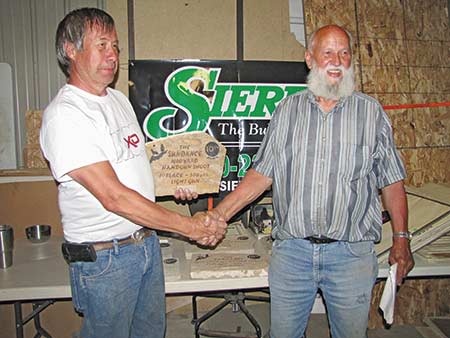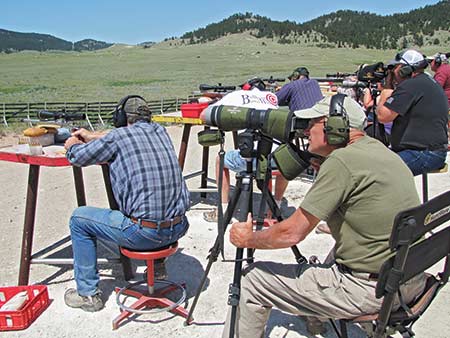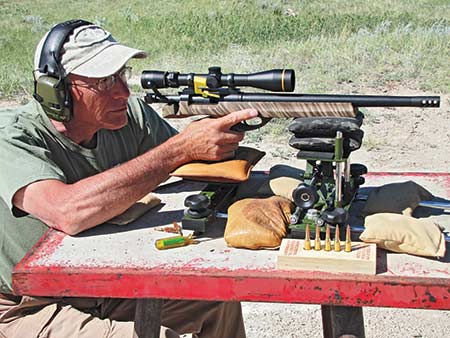| Game On |
0
Mark Hampton
The term “long range” can be mighty subjective. Long range may be defined as 100 yards, especially when handguns are involved. Yet others proclaim extended ranges beyond 300 yards better describe what long range is really about. Folks on the East Coast may deem long range totally different than those living out west in wide-open spaces. Living in the Midwest, I thought I had a pretty fair perception of “long range” shooting until I discovered the MOA Long Range Handgun Match. When I first heard some individuals were shooting handguns at 500, 750 and 1,000 yards, I thought somebody was pulling my leg. They weren’t!
This past year marked the 10th Anniversary of the MOA shoot held in Sundance, Wyoming. Richard Mertz, formally of the MOA Corporation and designer of the MOA Maximum handgun, has organized and hosted the shoot beginning back in 2007. It would be the third time my wife Karen and I attended. For me, it’s not about winning as much as accomplishing three goals—have fun, enjoy the camaraderie and learn something in the process. I’m happy to report all objectives were met and then some.
The event lasts three days with three different classes engaging targets at three different yardages. Light Gun Class allows guns up to 7.5 pounds with 15-inch barrel, not counting muzzlebrake. Hunter Class allows handguns up to 12 pounds with 15-inch barrel. The Heavy Gun Class includes handguns up to 16 pounds and 18-inch barrel, again, not counting muzzlebrake. Obviously the handguns involved are not your traditional revolvers or semi-autos but single-shot handguns chambered for bottleneck cartridges.
The event unfolds when a relay of shooters take to the line—usually seven or eight to a relay. Light Gun Class shoots first. The competitors have 5 minutes for sight-in, shooting an 18-inch square steel target. This time allows shooters to make necessary adjustments shooting as many rounds as desired. Competitors will normally have a spotter calling out hits and recommending scope adjustments. After the 5-minute period is over, five rounds only are placed on the bench. Shooters have 5 minutes to shoot a 5-shot group at a 6-inch bull’s-eye target—which is actually an NRA 100-yard high power rifle target. At the end of the first 5-shot group, targets are measured for group size indicating score. The bullet holes are taped by bright-colored stickers so the spotters can determine hits. Then, 5 more minutes for additional sighters shot on steel followed by 5 minutes for another 5-shot group. Again, the targets are measured for group size.
After a third and final round occurs, the three 5-shot groups are measured and represent score. Any shot off paper adds 21 to the total. The target is 21 inches wide. You don’t want to miss the paper! The next relay takes the line. After all shooters have finished, the top two scores from each relay will shoot-off. Usually six competitors take the line for one, 5-shot group to determine the winner.

Steve Martens (above, left) was a regular on the winner’s stage with four 1st Place honors.
He is presented his award by Richard Mertz. Becky Auer (below) enjoyed beating her dad—and
everyone else, finishing in 1st Place in the Heavy Gun class at 1,000 yards. Her father Pat
was on top of his game, taking three top honors.
After the Light Gun Class finishes shooting at 500 yards, Heavy Gun and Hunter Class will follow. It normally takes most of the day for all three classes to finish the 500-yard event. The following day all three classes tackle 750 yards with the final day reaching out to 1,000 yards. The 1,000-yard 42-inch target has a 13-inch bull’s-eye. Any shot off paper adds 42 to the total score.
It’s a treat to see the variety of equipment. The shooting rests run the gamut from simple to sophisticated. In the Light and Heavy Gun competition, most any form of rest is allowed provided the gun can be picked up from the rest itself—no rail gun concept. The Hunter Class allows only sandbags. All shooters were running riflescopes. More magnification than handgun scopes provide is necessary for this long-range pursuit. Leupold seemed to be most prevalent with Vortex, Sightron, Burris, and a few others in the fray with at least 20X magnification.
Single-shot handguns comprised of custom Remington XP-100’s, MOA Maximum, T/C Encore, H-S Precision, Savage Target actions and Freedom Arms with a few other custom builds filled the arena. Cartridges varied from .243 Winchester to .338 Lapua Magnum. The majority consisted of some variation of 6mm and 6.5mm calibers. Long, slender bullets with a high BC—Sierra, Berger and Hornady—were prevalent througout the match.
With such high magnification scopes—which are riflescopes—management of the sight picture requires an unusual technique. Even with effective muzzle-brakes, you don’t want to touch off one of these guns with your eye in the normal position. In order to find the target quickly, shooters will creep up to the ocular getting a full field of view. After target acquisition, shooters back off the eyepiece keeping the crosshairs centered in what now appears to be a donut-hole. This allows sufficient room for recoil without risking contact with the optic.
I shot the Light Gun division with an H-S Precision in .260 Remington topped with a Leupold VX-3i 4.5-14X. With handloads consisting of Nosler brass, CCI primers and Sierra 123-grain HPBT bullets over a charge of Varget. Shockingly, I placed second in the 750-yard Light Gun event. For the Hunter Class I shot an Encore also chambered in .260 Remington, fitted with a custom Bullberry barrel and Leupold’s new VX-3i in 4.5-14X. This handgun saw Lapua brass with basically the same components. It was a bigger shock when I placed second in the Hunter Class 1,000-yard event!
Some shooters managed unbelievable groups such as Steve Martens with his Savage Target action in 6mm Dasher. With the help of Leupold’s 6-20X scope, Steve won the 500-yard Light Gun shoot-off with a 2-5/16-inch 5-shot group. He went on to take top honor in the Heavy Gun and Hunter events along with the 750-yard Light Gun. Steve shot a custom XP-100 in the Heavy Gun with a 6 Dasher.

Mark spots for Bob Baker shooting a Freedom Arms Model 2008 in .260 Rem.

Mark checking his target through his Leupold VX-3i 4.5-14X scope on top
of an H-S Precision in .260 Remington. Gun is steady on a Hyskore rest.
The father/daughter duo of Pat and Becky Auer were dialed-in to say the least. Pat won the Heavy Gun and Hunter Class at 750 yards and Light Gun at 1,000. He was shooting an MOA in 6×47 Lapua for the Light and Hunter events along with a custom XP in the Heavy Gun. Unfortunately Pat was beat out slightly in the Heavy Gun at 1,000 yards—by his daughter! Becky shot well all three days with her MOA in 6.5×47 Lapua.
Representing our neighbors to the north, Mike Derosier from Canada won the 1,000-yard Hunter Class with his Savage Target action in 6.5×47 Lapua. Everyone had a great time.
This shooting event is a friendly competition among like-minded long-range handgunners. It was common to see competitors helping and assisting other competitors shooting right alongside each other. Everyone involved was eager to help fellow shooters. Spotters played a huge role during shooting competition. After shooting this event three different years, I have yet to see a calm day. Inconsistent wind gusting over 25 mph makes shooting at these ranges rather challenging. Spotters determine shot placement and assist with scope adjustments. A good spotter can make a good shooter better. It’s difficult to fathom how much a bullet drifts at 1,000 yards in windy conditions until you’ve experienced it.
While I don’t consider myself a bench-rest target shooter, I walked away from this shoot learning a lot about trajectory, wind drift, bullet choice, loading techniques and a lot more. Consistent grip, proper trigger squeeze and follow through, along with other shooting techniques come into play. Reading and doping the wind is essential. Shooters who are good at it usually do well. This learning experience it definitely will make you a better shooter—and in my case, a better hunter. No, I don’t plan on shooting game at 1,000 yards, but a 200-yard whitetail will now seem like a chip shot.
Karen and I had so much fun this year we already have made plans to return. My wife informed me she would be shooting next year and already has Bob Baker of Freedom Arms building her a Model 2008 single-shot in .260 Remington. Now I have more ammo to load! The MOA Long Range Handgun Match is fun, humbling, challenging, rewarding, and educational. Best of all a great group of individuals is involved—and willing to help. Lord knows I need the help! Want to enjoy some long-range handgunning and have a blast? See you in Sundance.
Richard Mertz
825 Government Valley Road
Sundance, WY 82729
[email protected]
(307) 283-3030
Purchase A PDF Download Of The May 2017 Issue Now!


